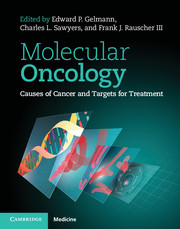Book contents
- Frontmatter
- Dedication
- Contents
- List of Contributors
- Preface
- Part 1.1 Analytical techniques: analysis of DNA
- Part 1.2 Analytical techniques: analysis of RNA
- Part 2.1 Molecular pathways underlying carcinogenesis: signal transduction
- Part 2.2 Molecular pathways underlying carcinogenesis: apoptosis
- Part 2.3 Molecular pathways underlying carcinogenesis: nuclear receptors
- Part 2.4 Molecular pathways underlying carcinogenesis: DNA repair
- Part 2.5 Molecular pathways underlying carcinogenesis: cell cycle
- Part 2.6 Molecular pathways underlying carcinogenesis: other pathways
- Part 3.1 Molecular pathology: carcinomas
- Part 3.2 Molecular pathology: cancers of the nervous system
- Part 3.3 Molecular pathology: cancers of the skin
- Part 3.4 Molecular pathology: endocrine cancers
- Part 3.5 Molecular pathology: adult sarcomas
- Part 3.6 Molecular pathology: lymphoma and leukemia
- Part 3.7 Molecular pathology: pediatric solid tumors
- Part 4 Pharmacologic targeting of oncogenic pathways
- 78 Oncology drug discovery for biologics: antibody development strategies and considerations
- 79 Targeting the EGFR family of receptor tyrosine kinases
- 80 Therapeutic approaches with antibodies to cell-surface receptors
- 81 Signal transduction in tumor angiogenesis
- 82 Tyrosine-kinase inhibitors in oncology
- 83 Anti-estrogens and selective estrogen-receptor modulators
- 84 Therapeutic applications of anti-sense mechanisms for the treatment of cancer
- 85 Induction of apoptosis
- 86 DNA-methylation inhibitors
- 87 Histone deacetylase inhibitors
- 88 Drug resistance: as complex and diverse as the disease itself
- 89 Molecular profiling and therapeutic decision-making: the promise of personalized medicine
- 90 DNA repair inhibition in anti-cancer therapeutics
- Index
- References
85 - Induction of apoptosis
from Part 4 - Pharmacologic targeting of oncogenic pathways
Published online by Cambridge University Press: 05 February 2015
- Frontmatter
- Dedication
- Contents
- List of Contributors
- Preface
- Part 1.1 Analytical techniques: analysis of DNA
- Part 1.2 Analytical techniques: analysis of RNA
- Part 2.1 Molecular pathways underlying carcinogenesis: signal transduction
- Part 2.2 Molecular pathways underlying carcinogenesis: apoptosis
- Part 2.3 Molecular pathways underlying carcinogenesis: nuclear receptors
- Part 2.4 Molecular pathways underlying carcinogenesis: DNA repair
- Part 2.5 Molecular pathways underlying carcinogenesis: cell cycle
- Part 2.6 Molecular pathways underlying carcinogenesis: other pathways
- Part 3.1 Molecular pathology: carcinomas
- Part 3.2 Molecular pathology: cancers of the nervous system
- Part 3.3 Molecular pathology: cancers of the skin
- Part 3.4 Molecular pathology: endocrine cancers
- Part 3.5 Molecular pathology: adult sarcomas
- Part 3.6 Molecular pathology: lymphoma and leukemia
- Part 3.7 Molecular pathology: pediatric solid tumors
- Part 4 Pharmacologic targeting of oncogenic pathways
- 78 Oncology drug discovery for biologics: antibody development strategies and considerations
- 79 Targeting the EGFR family of receptor tyrosine kinases
- 80 Therapeutic approaches with antibodies to cell-surface receptors
- 81 Signal transduction in tumor angiogenesis
- 82 Tyrosine-kinase inhibitors in oncology
- 83 Anti-estrogens and selective estrogen-receptor modulators
- 84 Therapeutic applications of anti-sense mechanisms for the treatment of cancer
- 85 Induction of apoptosis
- 86 DNA-methylation inhibitors
- 87 Histone deacetylase inhibitors
- 88 Drug resistance: as complex and diverse as the disease itself
- 89 Molecular profiling and therapeutic decision-making: the promise of personalized medicine
- 90 DNA repair inhibition in anti-cancer therapeutics
- Index
- References
Summary
Introduction
Apoptosis, or programmed cell death, is an evolutionary conserved genetic process of cellular suicide, which plays a crucial role in sculpting the developing organism and in “pruning” billions of unwanted, unneeded, or damaged cells every day during adult life (1). Aberrations of apoptosis leading to abnormal cell viability or excess cell death contribute to the pathogenesis of human diseases (2). However, these alterations are particularly important in cancer, where they impact virtually every facet of the disease, from onset to progression to treatment (3). As our knowledge of apoptotic pathways has dramatically increased over the past decade, so have the opportunities to harness this powerful cellular suicidal program for novel molecular cancer therapeutics (4).
As a result, apoptosis-based therapy is now a reality, and several new agents engineered to (re)awaken various mechanisms of cell death in tumors have entered clinical testing (5), producing, at least in some cases, intriguing, if not spectacular, patient responses. The early clinical trials have also opened fresh prospects for further elucidation of basic cell-death mechanisms, and identified key molecular requirements for sensitivity or resistance to this new class of therapeutics. From a drug-development perspective, the design of apoptosis-targeting agents has often defied conventional tenets of what may constitute a “drugable” target, and unlocked avenues for innovative drug-discovery platforms.
- Type
- Chapter
- Information
- Molecular OncologyCauses of Cancer and Targets for Treatment, pp. 903 - 907Publisher: Cambridge University PressPrint publication year: 2013

